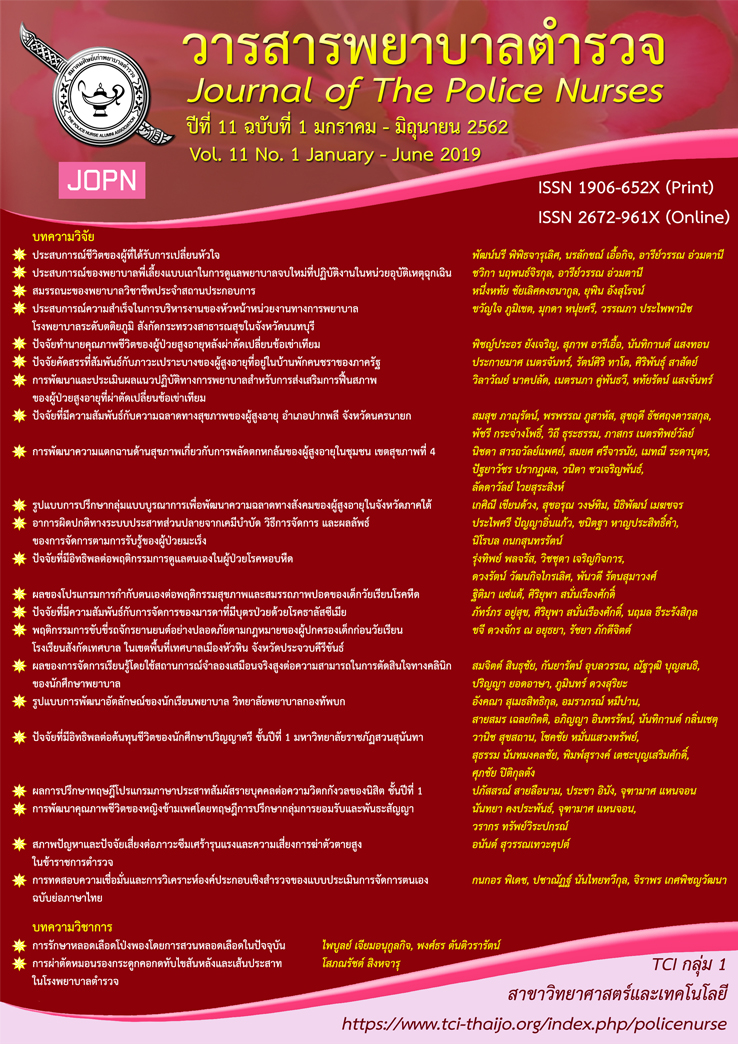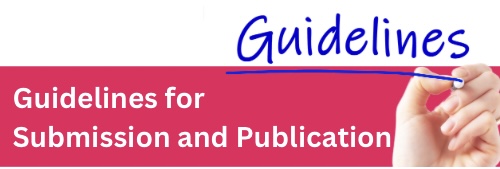FACTOR INFLUENCING SELF-CARE BEHAVIOR IN PATIENTS WITH ASTHMA
Keywords:
self-care behaviors, illness representation with asthma, patients with asthmaAbstract
The study of a predictive factor was influencing self-care behaviors in patients with asthma. The study covered all five dimensions of illness representation, namely, identify, cause, timeline, control/cure and consequences. Using the concept of the common-sense model of illness representation by Diefenbach and Leventhal (1996) was a conceptual framework. The samples consisted of 100 asthma patients who were recruited by purposive selection. The instrument was composed of the followings: 1) the general data questionnaire 2) the self-care behavior questionnaire for patients with asthma and 3) the illness perception questionnaire. The data were analyzed using descriptive statistics and multiple regression analysis.
The research findings were as follows: The samples were females (55%) with the average age of 40.51 years (SD = 12.64), having overall self-care behaviors at a good level (M = 101.46, SD = 14.40). According to multiple regression analysis, all of the independent variables were capable to explain the variance of self-care behaviors with statistical significance at 31.5 percent (R2 = .315, F(5,94) = 8.644, p = .000). Timeline, control/cure, and consequences were able to predict self-care behaviors with a significance level of .05.
The data obtained from this study will benefit nurses in setting self-care behavior promotion guidelines and proper education program development to create knowledge and understanding among patients. The results will be better self-care behavior modification.
Downloads
References
Boonsawat, W. (2007). Asthma. In N. Chierakul (Eds.), Textbook of respiratory systems. Bangkok: Parbpim Printing.
Boontiam, C. (2012). Self-care behavior of asthmatic patients in Wat Laung village, Nai Mueng subdistrict, Mueng district, Ubonratchathani province. National Research Conference.
Cochrane, M. G., Bala, M. V., Downs, K. E., Mauskopf, J., & Ben-Joseph, R. H. (2000). Patient compliance, devices, and inhalation technique. Chest, 177, 542-550.
Crowder, J. S., Hanna, M. K., Carpenter, S. J., & Broome, E. M. (2015). Factors associated with asthma self-management in African American adolescents. Journal of Pediatric Nursing, 30(6), 35-43.
Deshmukh, V. M., Toelle, B. G., Usherwood, T., Grady, B. O., & Jenkin, C. R. (2007). Anxiety, panic, and adult asthma: A cognitive-behavioral perspective. Respiratory Medicine, 101, 194-202.
Diefenbach, M. A., & Leventhal, H. (1996). The common-sense model of illness representation: Theoretical and practical considerations. Journal of Social Distress and the Homeless, 5(1), 11-38.
Global Initiative for Asthma. (2012). GINA report, global strategy for asthma management and prevention updated 2012. Retrieved from https://ginasthma.org.
Halm, E. A., Mora, P., & Leventhal, H. (2006). No symptoms, no asthma: The acute episodic disease belief is associated with poor self-management among inner-city adults with persistent asthma. Chest, 129(3), 573-580.
Hodder, R., Lougheed, M. D., Rowe, B. H., FitzGerald, J. M., Kaplan, A. G., & Mclvor, R. A. (2010). Management of acute asthma in adults in the emergency department: Non ventilatory management. The Canadian Medical Association Journal, 182(2), 55-67.
Kawamatawong, T. (2010). Asthmatic patients. in V. Sumethkul (Eds.), Medical problems in clinical practices. Bangkok: Offset creation.
Killeen, K., & Skora, E. (2013). Pathophysiology, diagnosis, and clinical assessment of asthma in the adult. Nursing Clinics of North America, 48, 11-23.
Kucukarslan, N. S. (2012). A review of published studies of patients’ illness perceptions and medication adherence: Lessons learned and future directions. Research in Social and Administrative Pharmacy, 8, 371-382.
Morris, R. M., Weinman, J., Petrie, K. J., Horne, R., Cameron, L. D., & Buick, D. (2002). The revised illness perception questionnaire (IPQ-R). Psychology and Health, 17(1), 1-16.
Muennipat, T. (2012). The factors influencing preventive health behaviors amongst asthmatic patients receiving services at the secondary level hospital in Nakhon Pathom province (A thesis of master of nursing science program, community nurse practitioner). Faculty of graduate studies, Christian University of Thailand, Nakhon Pathom.
Myers, T. R., & Tomasio, L. (2011). Asthma: 2015 and beyond. Respiratory care, 56(9), 1389-1410.
Polit, D. F., & Beck, C. T. (2012). Nursing research: Generating and assessing evidence for nursing practice (9th ed.). Philadelphia, PA: Wolters Kluwer Health/ Lippincott Williams and Wilkins.
Pornchalermpong, P., & Rattanapanont, N. (2016). Sulfites. Retrieved from https://www.foodnet worksolution.com/wiki/word/1955/sulfites.
Sirimai, P. (2012). Characteristics of inhaled steroids and Treatment results in asthmatic patients. Thai journal of tuberculosis chest diseases and critical care, 33(1), 43-49.
Strategy and Planning Division Ministry of Public Health. (2015). Public health statistics. Retrieved from https://bps.moph.go.th/
Tiggelman, D., Ven, M., Schayck, O., Kleinjan, M., & Engels, R. (2014). The common sense model in early adolescents with asthma: Longitudinal relations between illness perceptions, asthma control and emotional problems mediated by coping. Journal of Psychosomatic Research, 77(4), 309-315.
World Health Organization. (2015). World health fact sheet. Retrieved from https://www.who.int/news-room/fact-sheets/detail/asthma.
Downloads
Published
How to Cite
Issue
Section
License
ผลงานที่ได้ตีพิมพ์แล้วจะเป็นลิขสิทธิ์ของวารสารพยาบาลตำรวจ















